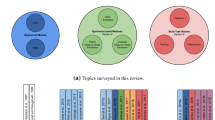Abstract
Purpose
For safe and reliable laparoscopic surgery, it is important to determine individual differences of blood vessels such as the position, shape, and branching structures. Consequently, a computer-assisted laparoscopy that displays blood vessel structures with anatomical labels would be extremely beneficial. This paper details an automated anatomical labeling method for abdominal arteries and veins extracted from 3D CT volumes.
Methods
The proposed method represents a blood vessel tree as a probabilistic graphical model by conditional random fields (CRFs). An adaptive gradient algorithm is adopted for structure learning. The anatomical labeling of blood vessel branches is performed by maximum a posteriori estimation.
Results
We applied the proposed method to 50 cases of arterial and portal phase abdominal X-ray CT volumes. The experimental results showed that the F-measure of the proposed method for abdominal arteries and veins was 94.4 and 86.9%, respectively.
Conclusion
We developed an automated anatomical labeling method to annotate each blood vessel branches of abdominal arteries and veins using CRF. The proposed method outperformed a state-of-the-art method.






Similar content being viewed by others
References
Shinoda T, Kitasaka T, Mori K, Suenaga Y, Misawa K, Fujiwara M (2008) A study on automated anatomical labeling of abdominal arteries extracted from 3D abdominal CT images, vol 107. Technical Report of IEICE, PRMU, pp 45–150
Suzuki Y, Okada T, Hori M, Yokota F, Linguraru M, Tomiyama N, Sato Y (2012) Automated anatomical labeling of abdominal arteries from CT data based on optimal path finding between segmented organ and aorta regions: a robust against topological variability. Int J CARS 7:S47–S48
Mori K, Oda M, Egusa T, Jiang Z, Kitasaka T, Fujiwara M, Misawa K (2010) Automated nomenclature of upper abdominal arteries for displaying anatomical names on virtual laparoscopic images. In: Medical imaging and virtual reality LNCS 6326, pp 353–362
Hoang BH, Oda M, Jiang Z, Kitasaka T, Misawa K, Fujiwara M, Mori K (2011) A study on automated anatomical labeling to arteries concerning with colon from 3D abdominal CT images, vol 7962. In: Proceedings of the SPIE, pp 79623R-1–79623R-9
Bilgel M, Roy S, Carass A, Nyquist PA, Prince JL (2013) Automated anatomical labeling of the cerebral arteries using belief propagation. In: Proceedings of the SPIE medical, imaging, pp 866918–866918
Robben D, Sunaert S, Thijs V, Wilms G, Maes F, Suetens P (2013) Anatomical labeling of the Circle of Willis using maximum a posteriori graph matching. In: MICCAI2013. Part I, LNCS 8149, pp 566–573
Ghanavati S, Lerch JP, Sled JG (2014) Automatic anatomical labeling of the complete cerebral vasculature in mouse models. NeuroImage 95:117–128
Bogunovic H, Pozo JM, Cardenes R, Roman LS, Frangi AF (2014) Anatomical labeling of the Circle of Willis using maximum a posteriori probability estimation. IEEE Trans Med Imaging 32:1587–1599
Matsuzaki T, Oda M, Kitasaka T, Hayashi Y, Misawa K, Mori K (2015) Automated anatomical labeling of abdominal arteries and hepatic portal system extracted from abdominal CT volumes. Med Image Anal 20:152–161
Sutton C, McCallum A (2006) An introduction to conditional random fields for relational learning. Intro. to statistical relational learning. The MIT Press, Cambridge
Duchi J, Hazan E, Singer Y (2011) Adaptive subgradient methods for online learning and stochastic optimization. J Mach Learn Res 12:2121–2159
Acknowledgements
The authors thank colleagues for suggestions and advice.
Author information
Authors and Affiliations
Corresponding author
Ethics declarations
Funding
This work was supported in part by a Grant-In-Aid for Scientific Research from the Ministry of Education, Culture, Sports, Science and Technology of Japan (26560255, 26108006, 25242047, 15K01344), the Japan Society for the Promotion of Science, and the Practical Research for Innovative Cancer Control from Japan Agency for Medical Research and Development (AMED).
Conflict of interest
The authors declare that they have no conflict of interest.
Ethical approval
The study was approved by the institutional review board of the Aichi Cancer Center.
Informed consent
Informed consent was obtained from all individual participants included in the study.
Appendix
Rights and permissions
About this article
Cite this article
Kitasaka, T., Kagajo, M., Nimura, Y. et al. Automatic anatomical labeling of arteries and veins using conditional random fields. Int J CARS 12, 1041–1048 (2017). https://doi.org/10.1007/s11548-017-1549-x
Received:
Accepted:
Published:
Issue Date:
DOI: https://doi.org/10.1007/s11548-017-1549-x




